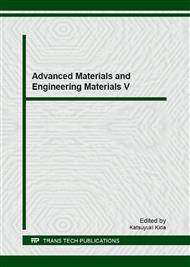[1]
B.F. Chong, L.M. Blank, R. Mclaughlin, L.K. Nielsen, Microbial hyaluronic acid production, Appl. Microbiol. Biotechnol. 66 (2005) 341-351.
DOI: 10.1007/s00253-004-1774-4
Google Scholar
[2]
G. Kogan, L. Sˆolte´s, R. Stern, P. Gemeiner, Hyaluronic acid: a natural biopolymer with a broad range of biomedical and industrial applications, Biotechnol. Lett. 29(2007) 17-25.
DOI: 10.1007/s10529-006-9219-z
Google Scholar
[3]
L. Liu, Y. Liu, J. Li, G. Du, J. Chen, Microbial production of hyaluronic acid: current state, challenges, and perspectives, Microb. Cell Fact. 10 (2011) 99.
DOI: 10.1186/1475-2859-10-99
Google Scholar
[4]
V. Rangaswamy, D. Jain, An efficient process for production and purification of hyaluronic acid from Streptococcus equi subsp. zooepidemicus, Biotechnol. Lett. 30 (2008) 493-496.
DOI: 10.1007/s10529-007-9562-8
Google Scholar
[5]
J. Zhang, X. Ding, L. Yang, Z. Kong, A serum-free medium for colony growth and hyaluronic acid production by Streptococcus zooepidemicus NJUST01, Appl. Microbiol. Biotechnol. 72 (2006) 168-72.
DOI: 10.1007/s00253-005-0253-x
Google Scholar
[6]
J.H. Kim, S.J. Yoo, D.K. Oh, Y.G. Kweon, D.W. Park, C.H. Lee, G.H. Gil, Selection of a Streptococcus equi mutant and optimization of culture conditions for the production of high molecular weight hyaluronic acid, Enzyme Microb. Technol. 19 (1996).
DOI: 10.1016/s0141-0229(96)00019-1
Google Scholar
[7]
E. Marcellin, J.A. Steen, L.K. Nielsen, Insight into hyaluronic acid molecular weight control, Appl. Microbiol. Biotechnol. 98 (2014) 6947–6956.
DOI: 10.1007/s00253-014-5853-x
Google Scholar
[8]
X. Hu, H. Li, J. Ding, S. Han, Mutagenic Mechanism of the A-T to G-C Transition Induced by 5-Bromouracil: An ab Initio Study, Biochemistry 43 (2004) 6361-6369.
DOI: 10.1021/bi049859+
Google Scholar
[9]
D.C. Armstrong, M.R. Johns, Culture conditions affect the molecular weight properties of hyaluronic acid produced by Streptococcus zooepidemicus, Appl. Environ. Microbiol. 63 (1997) 2759-2764.
DOI: 10.1128/aem.63.7.2759-2764.1997
Google Scholar
[10]
J.A. Vázquez, M.I. Montemayor, J. Fraguas, M.A. Murado, Hyaluronic acid production by Streptococcus zooepidemicus in marine by-products media from mussel processing wastewaters and tuna peptone viscera, Microb. Cell Fact. 9 (2010) 46.
DOI: 10.1186/1475-2859-9-46
Google Scholar
[11]
A.M. Pires, A.C. Macedo, S.Y. Eguchi, M.H. Santana, Microbial production of hyaluronic acid from agricultural resource derivatives, Bioresour. Technol. 101(2010) 6506–6509.
DOI: 10.1016/j.biortech.2010.03.074
Google Scholar
[12]
J.A. Vázquez, I. Rodríguez-Amado, M.I. Montemayor, J. Fraguas, P. González Mdel, M.A. Murado, Chondroitin sulfate, hyaluronic acid and chitin/ chitosan production using marine waste sources: characteristics, applications and eco-friendly processes: a review, Mar. Drugs. 11 (2013).
DOI: 10.3390/md11030747
Google Scholar
[13]
A.H. Oliveira, C.C. Ogrodowski, A.C. de Macedo, M.H. Santana, L.R. Goncalves, Cashew apple juice as microbial cultivation medium for non-immunogenic hyaluronic acid production, Braz. J. Microbiol. 44 (2013) 1097-1104.
DOI: 10.1590/s1517-83822014005000017
Google Scholar


